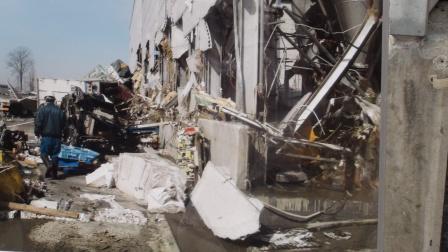Business Continuity Strategies for Manufacturing Companies
1. Introduction
 The considerations for Business Continuity Strategies occur in the fourth stage of the seven stage BCM planning process. Generally, there are three strategic areas for organisations to consider when developing a BC strategy: mitigation, recovery and its translation into the appropriate crisis response. For manufacturing companies, recovering plant operations is an important consideration when conducting BC planning. Unfortunately, setting aside alternate sites for this sector is usually avoided due to the high capital costs involved. An issue is also the practicability of having redundancies as back up as production efficiency is a key objective for manufacturers. Hence, many choose to focus on risk mitigation and reduction measures due to the difficulty in finding continuity solutions. To this end, three focus areas are identified for such organisations: recovery strategies, mitigation measures and unique environmental considerations.
The considerations for Business Continuity Strategies occur in the fourth stage of the seven stage BCM planning process. Generally, there are three strategic areas for organisations to consider when developing a BC strategy: mitigation, recovery and its translation into the appropriate crisis response. For manufacturing companies, recovering plant operations is an important consideration when conducting BC planning. Unfortunately, setting aside alternate sites for this sector is usually avoided due to the high capital costs involved. An issue is also the practicability of having redundancies as back up as production efficiency is a key objective for manufacturers. Hence, many choose to focus on risk mitigation and reduction measures due to the difficulty in finding continuity solutions. To this end, three focus areas are identified for such organisations: recovery strategies, mitigation measures and unique environmental considerations.
2. Recovery Strategies
In the absence of alternate production sites, there are few recovery strategies available to manufacturers. Often, custom build equipment and assembly lines are used and cannot be easily substituted. The recovery options then available are; to delay when the impact is felt through use of buffer inventory / storage, selected recovery of production lines and ensuring that recovery / repair of operations is done quickly. Manufacturers typically focus on inventory controls and partial recoveries as it allows greater process control. In the event that the manufacturer’s operation is more skewed towards assembling semi-finished products from upstream suppliers, an additional option is available to them. Where some equipment found in their production line are similar to those of their suppliers’, manufacturers may attempt to resume limited production capabilities at their suppliers’ location. This arrangement is obviously limited to the availability of space and more importantly, the goodwill of the supplier to accommodate external personnel.
3. Mitigation Strategies
As mentioned, due to the general lack of alternatives faced by manufacturers, mitigation strategies are often prioritized. While measures taken should focus on either preventing or limiting the impact of a disruption, it should be done with floor operations in mind. A common example is the use of sprinkler systems to douse fires at the factory floor. As sprinkler systems typically activate all together, this would cause production equipment that were otherwise unaffected by the fire to be damaged. This can be avoided through the use of localised sprinkler discharges where each sprinkler needs to be independently activated. Further measures may include a dry delivery sprinkler system, where fluids are only directed to the discharge point upon activation. This prevents common problems like leakages which may be found in poorly maintained systems.
4. Unique Environmental Considerations
More uncommon mitigation strategies may place focus on the environmental regulations that the location may be subject to, where the direct costs incurred through a loss of production may be severely compounded by the costs of ‘cleaning up’. A recent example is the Deepwater Horizon oil spill, where the costs of fines, cleaning up and settlements reached approximately $40 billion. Perhaps a tweak in the old adage holds true for manufacturers; prevention is surely better than recovery.
5. About the Author
 Jeremy Wong is the Senior Vice President for BCM Institute and deputizes the President in his absence. He is also the Senior Vice President for consulting firm GMH Continuity Architects and is a senior management staff member responsible for all training and consulting initiatives. Jeremy is highly experienced in technology and project management; information security management, business process re-engineering, disaster recovery and business continuity planning. Prior to joining BCM Institute and GMH Continuity Architects, Jeremy Wong was the Head of Business Continuity Management for South Asia with Nomura, based in Singapore. He was responsible for planning and implementing BCM, developing policies, frameworks and standards to support BCM functions. Jeremy was also Vice President of Business Continuity Management with United Overseas Bank. He was a managing consultant with GMH Continuity Architects working on business continuity and disaster recovery projects such as the Asia Development Bank and the Stock Exchange of Thailand within the Asia Pacific region. Mr Wong was also a regional IT manager with Bax Global and spent a number of years working at JP Morgan and Anderson Consulting (now known as Accenture). At JP Morgan, he headed the IT Products and Services team in the Corporate Technology Group. He was instrumental in the set up of the Regional Hub Response Center for Asia-Pacific. Mr Wong was also a key member of their Business Continuity Planning team. At Anderson Consulting, he led in several major projects and implementation for property management, logistics and data warehousing solutions.
Jeremy Wong is the Senior Vice President for BCM Institute and deputizes the President in his absence. He is also the Senior Vice President for consulting firm GMH Continuity Architects and is a senior management staff member responsible for all training and consulting initiatives. Jeremy is highly experienced in technology and project management; information security management, business process re-engineering, disaster recovery and business continuity planning. Prior to joining BCM Institute and GMH Continuity Architects, Jeremy Wong was the Head of Business Continuity Management for South Asia with Nomura, based in Singapore. He was responsible for planning and implementing BCM, developing policies, frameworks and standards to support BCM functions. Jeremy was also Vice President of Business Continuity Management with United Overseas Bank. He was a managing consultant with GMH Continuity Architects working on business continuity and disaster recovery projects such as the Asia Development Bank and the Stock Exchange of Thailand within the Asia Pacific region. Mr Wong was also a regional IT manager with Bax Global and spent a number of years working at JP Morgan and Anderson Consulting (now known as Accenture). At JP Morgan, he headed the IT Products and Services team in the Corporate Technology Group. He was instrumental in the set up of the Regional Hub Response Center for Asia-Pacific. Mr Wong was also a key member of their Business Continuity Planning team. At Anderson Consulting, he led in several major projects and implementation for property management, logistics and data warehousing solutions.

